Thank you to the Whyte Museum of the Canadian Rockies for granting permission to the Park Warden Service Alumni to post this interview on our website.
This Oral History interview was funded in part by a research grant from the Government of Alberta through the Alberta Historical Resources Foundation.
Park Warden Alumni Society of Alberta
Oral History Phase 10, 2020
Phone Interview with Bill Dolan
Date/time: April 24, 2020 @1030
Interviewed by Monique Hunkeler
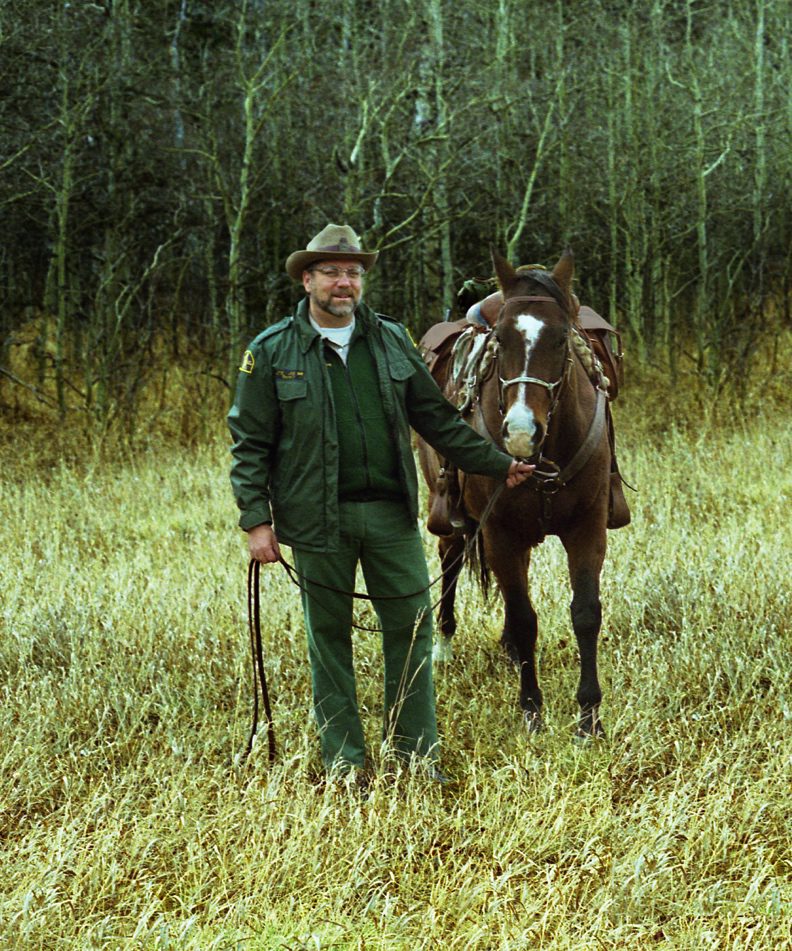
Waterton Lakes National Park 2000 Bill Dolan
Place and date of birth? Born in Winnipeg, Manitoba on June 10th, 1953
MH: Where did you grow up?
BD: I grew up in Winnipeg, Southern Manitoba. I spent a lot of my summers, recreational and work time, in Eastern Manitoba, Northwest Ontario, the Canadian Shield country.
MH: How did you become involved in the Warden Service? Which national park did you start working in?
BD: I was looking for a job as I was finishing my schooling in Toronto. I came back to Winnipeg in March, 1977 and drove around Western Canada knocking on doors. I went to the Calgary Office and talked with Jim Sime and he looked at my resume and said, “Well we won’t hire you because you’re from Manitoba, so go talk to Don Macmillan in the Prairie Regional Office in Winnipeg.” So I ended up back in Winnipeg and saw Don. My resume went on file and by June of that year I ended up getting an interview. I was successful and started as the Assistant Resource Studies Officer in the Prairie Regional Office in September, 1977. That position took me to a number of parks in northern Canada and the prairies. I worked with the Warden Service and managed the Parks Canada – Canadian Wildlife Service Research Program.
I really wanted to be in the field, in a park and not in a city, so I talked to Don Macmillan again. I got an offer as a 4-month seasonal Park Warden in Prince Albert National Park. We (my wife, Debbie and I) were stationed at the Crean Lake Warden Station in 1979. That’s also when I took my Basic Warden Training in Jasper. So, Prince Albert was our first National Park. We lived in the back of the garage. There was no housing available. The permanent warden, Cliff Millard was living in the Crean Lake Warden Cabin so the Chief Park Warden at the time, Dean Allan, offered us the back of the garage at the Warden Station. We put up drapes, painted the concrete floor and that’s where we spent the summer and fall.
0230: I did a Bachelor of Science in Zoology at the University of Manitoba and then I did my Masters of Science in Wildlife Management at the University of Toronto (Faculty of Forestry and Landscape Architecture).
MH: What made you want to join the Warden Service? 0322:
BD: I had been going out to the different Parks, Wood Buffalo, Prince Albert, Riding Mountain; doing some work on fire history, managing the research activities with the Canadian Wildlife Service and other projects. So as I worked in the field with different parks staff, I knew I didn’t want to be in the city for my career; that was not where I wanted to be. But at the time, there weren’t biologists in the Parks. There were some positions in the regional offices, but none in the parks. The resource management staff were all Park Wardens. So I thought, “I’d like to do that”. I was also quite open and interested in working outside my background and strengths in the resource side of things; so that is what really took me to the Warden Service.
MH: What different parks did you work in? How did they compare? Do you have a favourite? 0430:
BD: I worked in 5 different parks across western and northern Canada. I started out in May, 1979 at Prince Albert National Park at Crean Lake. I got my permanent Warden position in December of 1979 and that was at Sugarloaf Warden Station in Riding Mountain National Park. We spent three years there before they moved us to the townsite, Clear Lake or Wasagaming, in Riding Mountain. I spent a year there and then competed on and got the Area Manager I (Assistant Chief Park Warden) position in Wood Buffalo National Park, in Fort Smith, 1983-1987. That position was responsible for the northern portion of the park, north of the Peace River. In 1987, I was encouraged to apply on the Chief Park Warden position in a new national park – Northern Yukon. I was successful and we moved up to Inuvik in August, 1987. The name of the park was changed to Ivvavik, in collaboration with the Inuvialuit through a process that we started in 1989. In 1990, we moved down to Waterton and that was our fifth and last National Park.
0545: I thought about that question a bit. I guess you could lump Riding Mountain, Waterton and Prince Albert together and, in a lot of ways, there were many similarities. All three Parks had townsites and a lot of front country issues, bear management issues, which I was heavily involved in. But Riding Mountain and Prince Albert came along around 1930, whereas Waterton was one of the earliest National Parks in 1895 so it grew up with the community and arrival of many settlers. However, lands in Riding Mountain were available for hunting, haying and logging for 2-3 generations of settlers before it became a National Park. With the establishment of the Park, those activities were taken away. There was a lot of poaching in Riding Mountain when I was there and I dealt with a lot of incidents whereas, in Waterton, there was a stronger recreational focus in the backcountry. And then going north, similarly Wood Buffalo was established many years earlier and, again, laid over traditional indigenous use, First Nations use (Dene). So there was a lot of tension there, especially in the 1970s and early 1980s when the whole issue of Aboriginal Rights was taking the forefront and the Canadian Constitution was re-patriated to confirm those rights. But it was different in Inuvik. Ivvavik National Park was created by the Inuvialiut (western arctic Inuit) as part of their modern land claims settlement (Inuvialuit Final Agreement). So each park was created at a different time and in different circumstances in terms of the use by indigenous and non-indigenous communities.
For me, in terms of a favourite, it’s really hard. Every place was special, but if I had to tip it, I would pick Ivvavik National Park. It was one of those unique opportunities in a person’s career where you got to start a new National Park. Furthermore, I was the first manager on site to look after the first National Park in Canada established under a comprehensive land claim. Gord Antoniuk was there that first year too when we opened the office in Inuvik. We hired the current Superintendent, Linda Binder, in 1988. It’s not often that you get to start up a Park and work with the local community, especially with the Inuvialuit., We tried to set a positive tone and ensure that people understood what a National Park was. In a lot of cases Northerners looked at Banff and said, “Oh that’s what a National Park is, we don’t want that”. In reality, it was a great opportunity to create a different understanding. There were many times when decisions had to be made based on the Crown’s obligations under the Inuvialuit Final Agreement (IFA). You had to interpret the intent of the IFA and determine, okay, this is what was said and how does this action fit with our obligations under the IFA. The landscape was incredible; the north slope of the Yukon, the McKenzie River Delta and the people, the Inuvialuit. It was just an incredible experience. I was there for three years. We opened up the office in Inuvik in 1987. The Inuvialuit Final Agreement was signed in 1984 and legislation to establish the Park followed. Until 1987, the Park was actually managed from Kluane National Park by Charlie Zinkan who was the Superintendent. He was the one who called and asked if I wanted to apply on the job. Ray Frey was the Chief Park Warden for Northern Yukon and was also located in Haines Junction. It wasn’t until 1987 when Ray moved on to Riding Mountain that they opened up the office in Inuvik. That’s when we arrived and spent three years there. I still reported to the Superintendent in Kluane during my time in Inuvik.
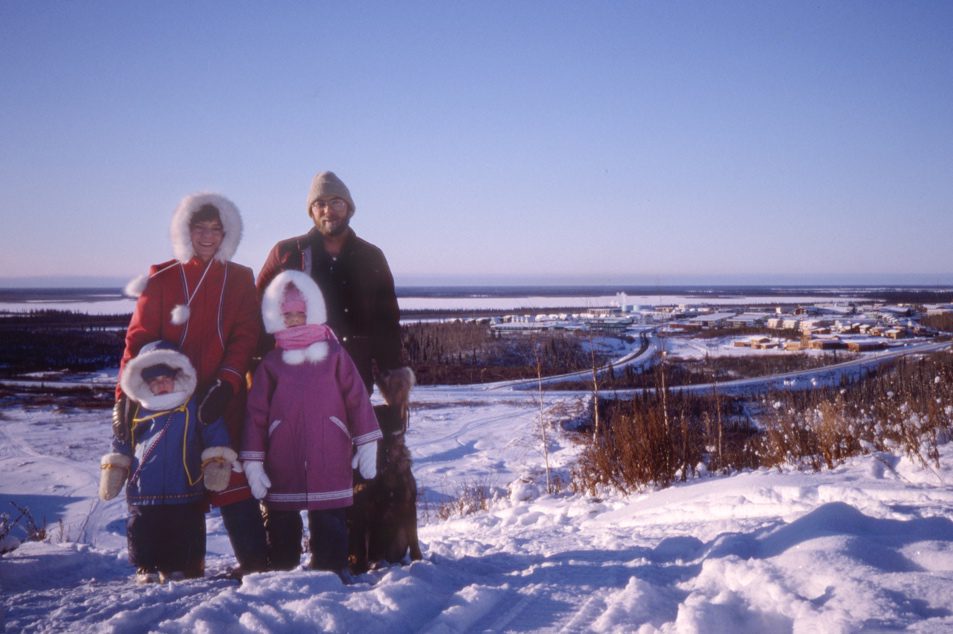
Inuvik_1988_Dolan Family_Bill, Debbie, Carrie and Ryan
MH: What were some of your main responsibilities over the years? 1025:
BD: In Prince Albert there was a lot of late night campground and front country enforcement. In Riding Mountain, at Sugarloaf, it was a fairly remote Warden Station, south of Grandview in the northwest corner of Riding Mountain, so you were really off on your own. A lot of the job was community relations, working with neighbours and communities but also a lot of law enforcement. Beyond big game poaching, there were a number of other enforcement issues including illegal skidoo use, cattle grazing and trapping. Wardens were also managing boundary related issues such as wounded wildlife going into the park and beaver dams that flooded private lands outside the park. People were poaching mostly elk but some moose as well. I would describe poaching in three broad categories. Those that would grab an elk for their freezer for the winter, not as big a deal but you would still deal with that if you could. Then there were the young guys who had grown up poaching with family or whoever. They would often go in as a recreational sport by horseback, with alcohol (still lots of white lightning or moonshine in that country when I was there). Then there was a third category which was probably more of a commercial aspect where the elk were taken out and sold. There was a range of poaching activities.
1258: In fall of 1982, they moved us into the townsite (Wasagaming). In both Prince Albert and Riding Mountain, I was heavily involved when they first started the Environmental Assessment Program. Also, I worked in a black bear research project in northern Ontario before joining Parks. As such, I was also assigned responsibility for the Bear Management Program in both those parks. In Wood Buffalo I was involved in a whole bunch of issues around indigenous use and I got out with some of the trappers. The Resource Management program was really big there in terms of indigenous hunting and trapping, bison, whooping cranes and commercial timber harvesting along the Peace River near Garden River. Inuvik was more of the same and, as I mentioned earlier, unique as a new park. We only had three person years so you ended up doing a whole host of things; everything from a Superintendent/Director level all the way down to a Patrol Person, and across all the sections, because you had to be a jack of all trades. In Waterton, I was heavily involved with the regional partnerships like the Waterton-Glacier International Peace Park, Waterton Biosphere Reserve, Prairie Conservation Forum and the Crown Managers Partnership. Waterton played a pivital role in establishing the Miistakis Institute, currently at Mount Royal University in Calgary. I worked closely in supporting the Nature Conservancy of Canada (NCC) in the 1990s as they worked with the ranching community and developed agreements to protect much of the private lands adjacent to Waterton (ie. the Waterton Front project). I also took on a lead role in the park warden recruitment program for the Western Region in 1994 and helped shepherd the process, with others, into a national program over the subsequent decade.
MH: What did you like / Dislike about being a warden? 1410:
BP: The diversity of the job was probably the thing that I enjoyed the most and the independence that came with it. Whether it was opening up the Parks office and presence in Inuvik or working in a district station in Riding Mountain. I’d never ridden a horse before. My boss, Keith Foster, brought me my saddle horse and pack horse and said, “This is how you saddle a horse; This is how you feed a horse; This is how you get off and on a horse; Where’s your coffee pot? And good bye.” That was all the training for my first year. That said, I went everywhere on my saddle horse, both on and off trails. His name was Red and my pack horse was Trigger. I took air photos with me and I went places where I never should have taken a horse. So I really enjoyed that independence and, of course, the Parks mandate has such a strong protection element; the role is easy to relate to. The protection mandate also involved working with people and I really enjoyed building bridges with people and the park mandate. At the same time, you have to recognize that you are part of a much larger organization and mandate across the country; you’re not just one park. There is so much that I enjoyed.

Riding Mountain National Park_Ochre River trail_1983_ Bill Dolan

Riding Mountain_Ochre River camp_1983_ Bill Dolan and dog Shep
1545: Honestly, I enjoyed all aspects of the job and it’s hard to think of anything I didn’t like. But if there was one thing that was always tougher to do, as a supervisor/manager, was dealing with staff relations issues which happened periodically, but not that often. None the less, those were tough because these were often people who were part of the team and you had to take some minor or major corrective action. That was never easy, but it had to be done.
MH: What were some of your more memorable events as a Warden? 1630:
BD: There are so many! I talked about Ivvavik and there was so much there in terms of planning and the logistics in establishing the Sheep Creek Operations Centre in the Park. It was the most northern park construction site in Parks Canada. Also, an incident that I thought of was unique. When we first got there, the eastern boundary of the Park was along the Babbage River on the north slope of the Yukon. The river drains through a large delta into the Beaufort Sea. Someone had asked a lawyer in Ottawa, where the boundary was through the Delta because it wasn’t really clear in the National Parks Act description. The lawyer said, “Just to be safe, let’s draw it on the west side so we take the whole Delta out of the Park and then that way, we’ll know for sure, there’ll be no ambiguity.” So I ripped up the legal advice letter, threw it in the garbage and said, “Let’s draw the map and make sure that the boundary is on the east side of the delta and the whole delta is in the Park”, which was a large area. Basically, by doing what we did, everybody gets used to the boundary location so when they look at the National Parks Act ten years later they’ll say, “Oh well it has always been here on the map so that must have been what they intended”. That is a small example that speaks to the independence and the ability to move forward. In reality, I realized later that the Inuvialuit Final Agreement was clear on the boundary location but the National Parks Act was more ambiguous.
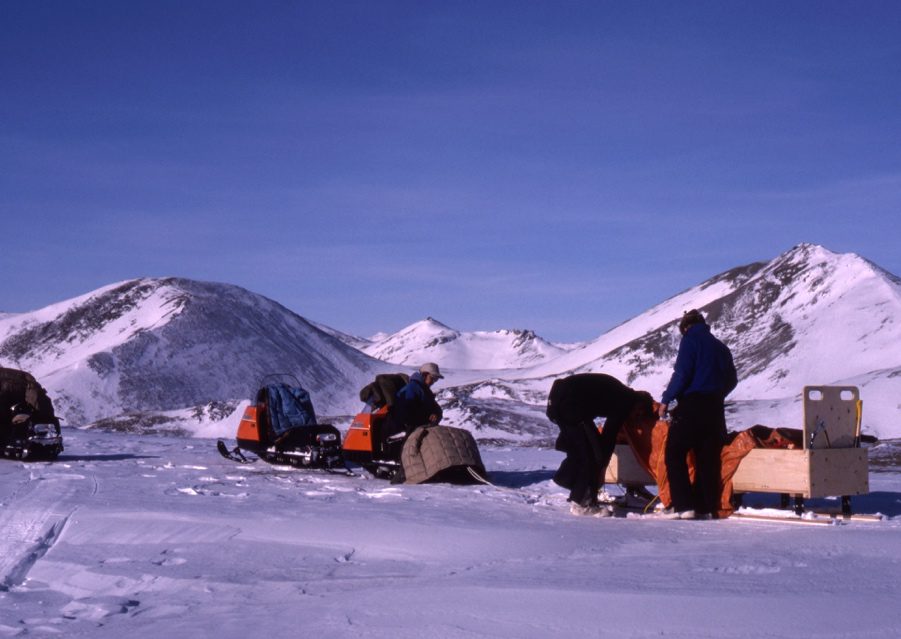
Ivvavik NP_March, 1990_First winter warden patrol_Pass between Sheep Cr and Malcolm_Bill Dolan, Dan Frandsen, Clint Toews, Lawrence Kayotuk
Another example was in 1992, just after I had come down to Waterton, I was asked to chair an Ecosystem Management Task Force for Western Region with Dr. Bernie Lieff and Ross McDonald. It was really a point where Parks was starting to recognize the importance of working outside of park boundaries. Many staff had done that before but this was trying to put the concept into a framework that would ensure, as an organization, we were thinking about a variety of different principles and approaches to be more successful. In the early years much of the pressure and focus was inside the park (and it’s still there) but nowadays, a lot of the pressure is coming more from the outside. This was a way to engage parks staff and others outside of parks to enhance protection in a shared landscape. So that was a highlight.
1923: The Sofa Mountain fire in 1998 in Waterton was another major event. It was a wind driven (80 kilometer/hour) fire that started at 0200 in the morning and it was moving quite fast towards the private ranchlands east of the Park. It was a pretty crazy time but one of the things I did was bring together organizations and government representatives that could be impacted by the fire in an overhead “incident command team”. This group received daily briefings from the Park, ensured their organization had the best information and provided support to the Park. We also asked them for input and recommendations at key stages of the operation. This was a time before the Incident Command System (ICS) was even recognized and used in Canada. Intuitively, we basically adopted a model that was very similar. Steve Otway was down looking after the operations of the fire with the Parks Canada overhead fire team. It wasn’t until the following 5-10 years that Parks Canada actually adopted the Incident Command System which was a United States model. Our close working relationship with US National Parks Service and Glacier National Park staff helped inform our approach in subsequent years. That was a memorable event in that sense, as well as the communications we built during and after the fire.
In terms of ecosystem management, we did a lot in Waterton. I was involved in getting the Crown Managers Partnership established with two close friends (Brace Hayden – Glacier National Park and Ian Dyson – Alberta Government). I really enjoyed working with a number of landscape partnerships, whether it was the Prairie Conservation Forum or others. Those were all really rewarding.
But I guess one of the things that touched me the most, and what I really value, is how staff or peers see your performance as a supervisor or manager. I was nominated twice by my staff for the Parks Canada People Management Award (in 1990s and 2000s), which was to me most rewarding. Hearing from your staff and your peers is most telling in terms of what kind of job you are doing. That was something that meant a lot.
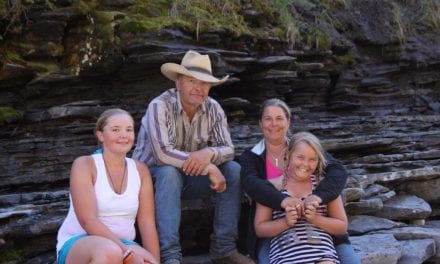

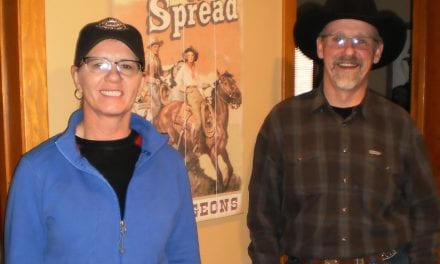
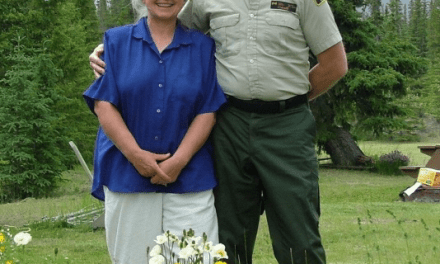
Bill you had a great career in the Service, i was glad to have worked with you.